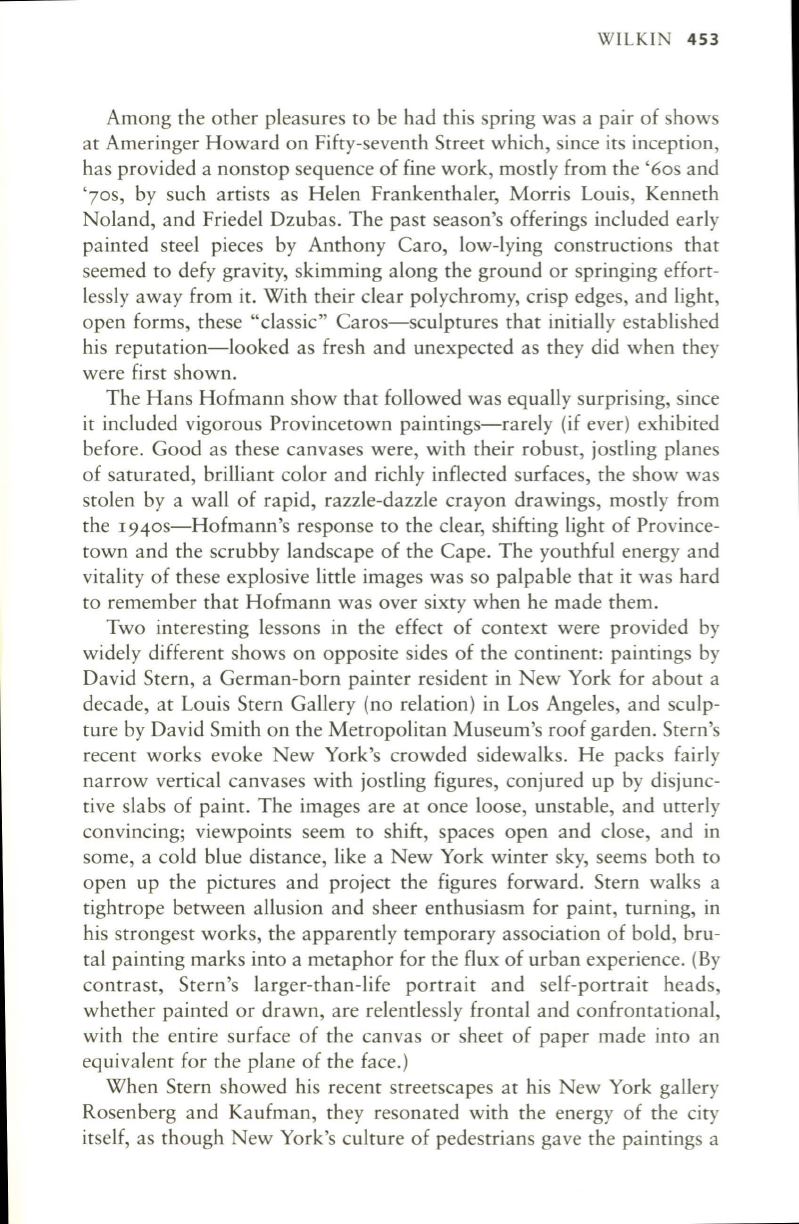
WILKIN
453
Among the other pleasures to be had this spring was a pair of shows
at Ameringer Howard on Fifty-seventh Street which, since its inception,
has provided a nonstop sequence of fine work, mostly from the
'60S
and
'70S,
by such artists as Helen Frankenthaler, Morris Louis, Kenneth
Noland, and Friedel Dzubas. The past season's offerings included early
painted steel pieces by Anthony Caro, low-lying constructions that
seemed to defy gravity, skimming along the ground or springing effort–
lessly away from it. With their clear polychromy, crisp edges, and light,
open forms, these "classic" Caros-sculptures that initially established
his reputation-looked as fresh and unexpected as they did when they
were first shown.
The Hans Hofmann show that followed was equally surprising, since
it included vigorous Provincetown paintings-rarely (if ever) exhibited
before. Good as these canvases were, with their robust, jostling planes
of saturated, brilliant color and richly inflected surfaces, the show was
stolen by a wall of rapid, razzle-dazzle crayon drawings, mostly from
the 194os-Hofmann's response to the clear, shifting light of Province–
town and the scrubby landscape of the Cape. The youthful energy and
vitality of these explosive little images was so palpable that it was hard
to remember that Hofmann was over sixty when he made them.
Two interesting lessons in the effect of context were provided by
widely different shows on opposite sides of the continent: paintings by
David Stern, a German-born painter resident in New York for about a
decade, at Louis Stern Gallery (no relation) in Los Angeles, and sculp–
ture by David Smith on the Metropolitan Museum's roof garden. Stern's
recent works evoke New York's crowded sidewalks. He packs fairly
narrow vertical canvases with jostling figures, conjured up by disjunc–
tive slabs of paint. The images are at once loose, unstable, and utterly
convincing; viewpoints seem to shift, spaces open and close, and in
some, a cold blue distance, like a New York winter sky, seems both to
open up the pictures and project the figures forward. Stern walks a
tightrope between allusion and sheer enthusiasm for paint, turning, in
his strongest works, the apparently temporary association of bold, bru–
tal painting marks into a metaphor for the flux of urban experience. (By
contrast, Stern's larger-than-life portrait and self-portrait heads,
whether painted or drawn, are relentlessly frontal and confrontational,
with the entire surface of the canvas or sheet of paper made into an
equivalent for the plane of the face.)
When Stern showed his recent streetscapes at his New York gallery
Rosenberg and Kaufman, they resonated with the energy of the city
itself, as though New York's culture of pedestrians gave the paintings a


